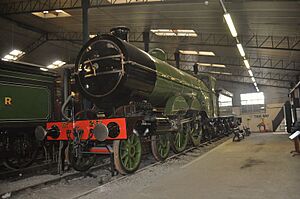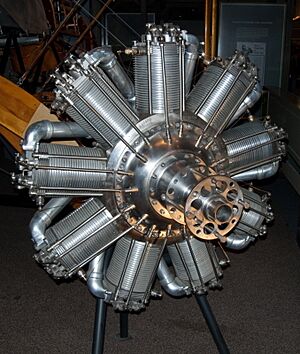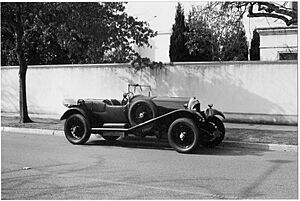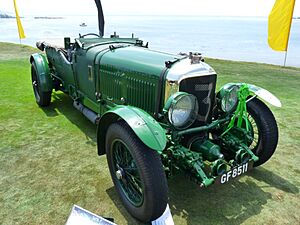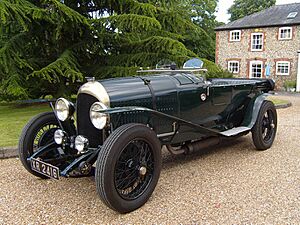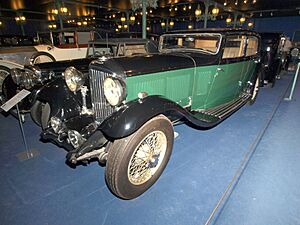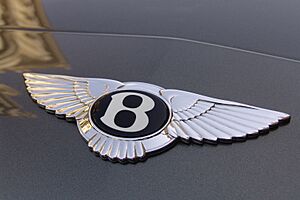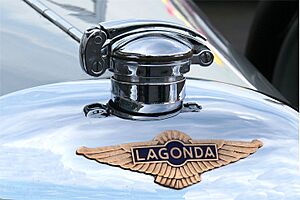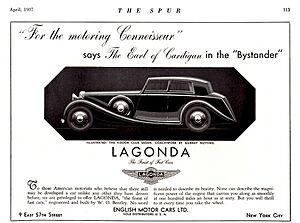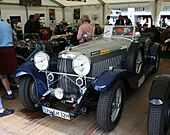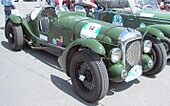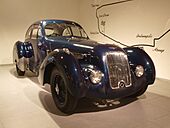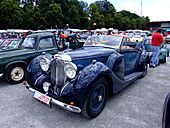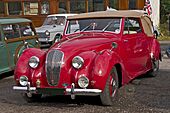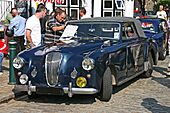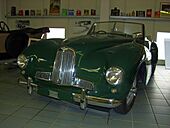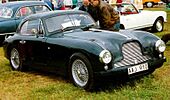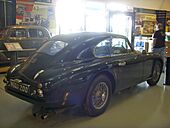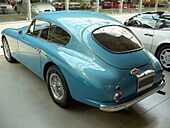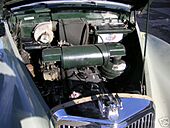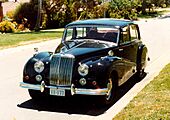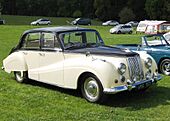W. O. Bentley facts for kids
Quick facts for kids
Walter Bentley
|
|||||||||||||||
|---|---|---|---|---|---|---|---|---|---|---|---|---|---|---|---|
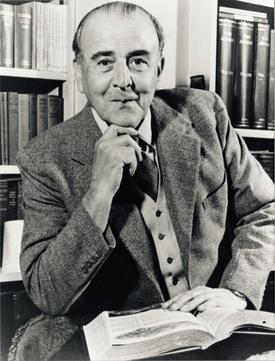 |
|||||||||||||||
| Born | 16 September 1888 Hampstead, England
|
||||||||||||||
| Died | 13 August 1971 (aged 82) Woking, England
|
||||||||||||||
| Alma mater | King's College London | ||||||||||||||
| Known for | Founder of Bentley | ||||||||||||||
|
|||||||||||||||
Walter Owen Bentley, MBE (born September 16, 1888 – died August 13, 1971) was an English engineer. He is famous for founding the luxury car company Bentley in London. When he was young, he loved racing motorcycles and cars.
After becoming known for designing aircraft and car engines, Bentley started his own company in 1919. He built Bentley into one of the world's top luxury and performance car makers. His cars won many races, including the famous 24 Hours of Le Mans. Later, he worked as a designer for other car companies like Lagonda and Aston Martin.
Contents
Early Life and Learning
Walter Bentley was born in Hampstead, London, on September 16, 1888. He was the youngest of nine children. His father, Alfred Bentley, was a successful businessman.
Walter went to a private school called Clifton College in Bristol from 1902 to 1905. When he was 16, he left school to become an apprentice engineer. He started working for the Great Northern Railway in Doncaster.
Working with Trains
Walter's five-year apprenticeship with the Great Northern Railway cost his father £75. During this time, he learned how to design complex railway machines. He also gained hands-on experience in building them.
He loved trains, especially the powerful "Atlantic express locomotives." He even got to work as a second fireman on main-line trains. This meant shoveling tons of coal! He once said, "My longest day was London to Leeds and back." He finished his training in 1910. But he felt that railways did not offer enough exciting opportunities for him.
Racing Motorcycles
In 1909 and 1910, Walter Bentley raced motorcycles. He rode bikes from brands like Quadrant, Rex, and Indian. He competed in two Isle of Man Tourist Trophy races. However, he did not finish either race. In 1910, his Indian motorcycle's tire burst during the race.
Learning More About Engineering
After his railway apprenticeship, Walter studied engineering at King's College London. Then, he got a job at the National Motor Cab Company. Here, he helped maintain 250 taxi cabs. He learned a lot about how cars worked and how to keep them running.
Starting in the Car World
In 1912, Walter joined his brother, Horace, in a company called "Bentley and Bentley." They sold French DFP cars. Walter was not happy with how these cars performed. He believed that winning races was the best way to sell cars.
He had an idea to make the car engines better. He used aluminum alloy for the pistons instead of heavier metal. This made the engines more powerful and run cooler. With these new pistons, a DFP car set several records at the Brooklands race track in 1913 and 1914.
Designing Aero Engines
When World War I started, Bentley knew his aluminum alloy pistons could help the war effort. They made aircraft engines more powerful and reliable. He joined the Royal Naval Air Service. His job was to share his knowledge with engine manufacturers.
He visited companies like Rolls-Royce and Sunbeam. Thanks to his ideas, their first aircraft engines used aluminum pistons. This was a big improvement.
Bentley also worked with Gwynnes, a company that made French Clerget engines. When they didn't want to make his suggested changes, the Navy gave him his own team. They designed his own aircraft engine at the Humber factory. This engine was called the BR1, which stood for Bentley Rotary 1. A bigger version, the BR2, followed in 1918.
For his important work, Bentley was awarded the MBE. He also received £8,000 for his inventions.
Bentley Motors
After World War I, in early 1919, Bentley started his own car company. He called it Bentley. He set up shop in a small place in London. His team included Frank Burgess and Harry Varley. Clive Gallop joined to help design their first engine.
The first Bentley 3-litre engine ran in London. A special plaque marks the building today. Bentley's first complete car was tested in January 1920. The first car sold was delivered in September 1921. These cars were known for being very strong and reliable.
Bentley's goal was "To build a good car, a fast car, the best in class." His cars raced in many events. A Bentley 3-litre finished thirteenth in the 1922 Indianapolis 500 race. Bentley also entered a team of his 3-litre cars in the 1922 Tourist Trophy. His team was the only one to finish, winning the Team Award. This helped make Bentley's reputation famous.
Bentley cars set many records at the 24 Hours of Le Mans races. A group of drivers called the "Bentley Boys" became very famous. One of them, Woolf Barnato, won the race all three times he entered.
In 1923, Bentley was not sure about attending the first Le Mans race. But he went and saw a private Bentley car take fourth place. A Bentley 3-litre won Le Mans in 1924. Bentley cars won again in 1927, 1928, 1929, and 1930.
The famous car designer Ettore Bugatti once joked that Bentley made "the fastest lorries in the world."
Bentley Motors faced money problems. Woolf Barnato, a rich diamond businessman, bought the company. He became the chairman.
Bentley continued to design cars for Barnato. The racing version of the six-cylinder Speed Six was very successful. It won Le Mans in 1929 and 1930. In 1929, Barnato approved a supercharged "Blower" version of the 4½ Litre car. Bentley did not want this car, and it often broke down during races.
Even though Bentley cars were still winning, the Great Depression caused financial difficulties. By July 1931, Bentley Motors went out of business.
Cars Made in Cricklewood
| Year | 3-litre | 4-litre | 4½-litre | 6½-litre | 8-litre | Total |
|---|---|---|---|---|---|---|
| 1922 | 145 | 145 | ||||
| 1923 | 204 | 204 | ||||
| 1924 | 403 | 403 | ||||
| 1925 | 395 | 395 | ||||
| 1926 | 295 | 58 | 353 | |||
| 1927 | 140 | 127 | 267 | |||
| 1928 | 45 | 273 | 99 | 417 | ||
| 1929 | 8 | 260 | 129 | 397 | ||
| 1930 | 138 | 126 | 264 | |||
| 1931 | 50 | 56 | 100 | 206 | ||
| 1931+ | 4 | 6 | 10 | |||
| Total | 1,639 | 50 | 733 | 539 | 100 | 3,061 |
- 506 of the 3-litre cars were 'Speed Models'.
- 54 of the 4½-litre cars had superchargers.
- 171 of the 6½-litre cars were 'Speed Sixes'.
Rolls-Royce Buys Bentley
In November 1931, Rolls-Royce bought Bentley Motors. Rolls-Royce was worried that Bentley's 8 Litre car was competing with their own luxury cars. Rolls-Royce bought the Bentley showrooms and factories. They also hired Walter Bentley himself.
The old Bentley factory in Cricklewood closed in 1932. After that, Bentley cars were made at Rolls-Royce factories. Rolls-Royce wanted to use the Bentley name for smaller, more affordable cars. But these new cars turned out to be just as complex and expensive as Rolls-Royces.
Walter Bentley had a difficult time after his company was sold. His wife divorced him, and he even had to return his own Bentley car.
Working for Rolls-Royce
Walter Bentley had a contract to work for Rolls-Royce until April 1935. Rolls-Royce kept him busy testing cars. He drove vehicles at the Brooklands track and took long test drives across Europe.
He was mostly allowed to comment on the design of the new 3½-litre car. This car was released in October 1933. Bentley admired the car, even though he had little say in its design. Rolls-Royce promoted these new Bentleys as "The Silent Sports Car." Walter Bentley left Rolls-Royce in April 1935, feeling free.
Working at Lagonda
In 1935, a Lagonda car won the Le Mans 24-hour race. Soon after, the company faced financial trouble. Alan P Good saved Lagonda from closing. Walter Bentley joined the new board as Technical Director. Many of Rolls-Royce's racing staff also moved to Lagonda with him.
Bentley started designing a new V12 engine. This engine was launched in 1937. It was very powerful, producing 180 horsepower. It could go from 7 to 105 mph in top gear!
During World War II, Bentley worked on weapons at Lagonda. Towards the end of the war, he began designing a new straight-6 engine. He knew that the V12 engine would be too expensive after the war. This new engine was modern and efficient. It would be used in cars starting in 1948.
However, Lagonda faced problems getting enough materials like steel. In 1947, Lagonda announced that they had to cancel plans for the new Bentley-designed cars. The company had to let go of many workers.
- Lagonda Cars Engineered by W. O. Bentley
Working at Aston Martin
A month later, in September 1947, David Brown & Sons bought Lagonda. David Brown had also bought Aston Martin earlier that year. Brown mainly bought Lagonda to get Walter Bentley's engineering skills.
Bentley's newest engine design, the 2.6-litre straight-6, was put into Brown's new DB2 car. This strong engine was used in Lagondas and Aston Martins until 1959. Bentley noted that many of its design ideas were even used in later V8 engines.
- Aston Martin Cars Engineered by W. O. Bentley
Working at Armstrong Siddeley
After Aston Martin-Lagonda, Bentley moved to Armstrong Siddeley. There, he designed another 3-litre engine before he retired. His team worked on the Sapphire car project. Even though Bentley's specific engine design was too expensive to produce, his involvement helped the Sapphire car gain respect from other designers.
- Armstrong Siddeley Cars Engineered by W. O. Bentley
Personal Life and Legacy
Walter Bentley was married three times. His first wife, Leonie Gore, died in 1919. In 1920, he married Poppy Hutchinson. They divorced after his company was sold in 1931. In 1934, he married Margaret Roberts Hutton, who stayed with him until his death. He did not have any children.
Walter Owen Bentley passed away on August 13, 1971, just before his 83rd birthday. He was the patron of The Bentley Drivers' Club. This club was founded in 1936 and now has nearly 4,000 members worldwide.
In 1995, Walter Bentley was honored by being inducted into the Automotive Hall of Fame. This shows how important his contributions were to the world of cars.



